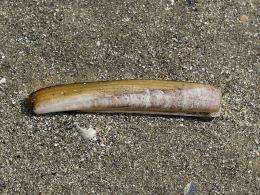May 25, 2012 report
Study uncovers secret to speedy burrowing by razor clams

(Phys.org) -- If you look at a razor burrowing clam sitting in a bucket, you’d never guess that it could burrow itself down into the soil, much less do it with any speed. Razor clams look like fat straws, or sawed off tusks; not very exciting. But set one down in the water, and it can burrow down into the sand to about two and a half feet deep in just a couple of minutes. Pretty impressive stuff, especially considering, as a team of researchers has found, that the muscle the clams use for burrowing just isn’t strong enough to accomplish the deed. To manage the speedy descent the team found, the razor burrowing clam causes changes to the sand below it as it descends. They have written a paper on their findings which has been published in the Journal of Experimental Biology.
What happens the team writes, is that the clam pushes down into the sand just a few centimeters using a soft foot on its bottom end. Then, it constricts valves inside its shell, causing a sudden vacuum to exist in the sand around the foot. That vacuum is then filled almost instantly with water rushing in from the surrounding saturated sand, making the sand just below the foot more mushy. This allows the clam to push down a little farther, at which point it constricts again. Performing this ritual over and over allows the clam to burrow itself down into the sand at a pretty fair clip.
To find all this out, the research team built an environment in their lab that would allow for careful study of the actions of the burrowing clam. They constructed a waterproof tank into which they dumped clear glass beads to serve as sand, added water and then filmed the action as volunteer clams burrowed themselves into the imitation sand. Watching in slow motion they discovered that the clams essentially turned the area below them into quicksand, allowing for a relatively swift descent.
The results found by the team not only help explain how the clam is able to burrow so quickly but might also help researchers in other areas, namely, those working on trying to figure out how to get undersea robots to tether themselves to the seafloor.
More information: Localized fluidization burrowing mechanics of Ensis directus, Journal of Experimental Biology, doi: 10.1242/jeb.058172
Abstract
Muscle measurements of Ensis directus, the Atlantic razor clam, indicate that the organism only has sufficient strength to burrow a few centimeters into the soil, yet razor clams burrow to over 70 cm. In this paper, we show that the animal uses the motions of its valves to locally fluidize the surrounding soil and reduce burrowing drag. Substrate deformations were measured using particle image velocimetry (PIV) in a novel visualization system that enabled us to see through the soil and watch E. directus burrow in situ. PIV data, supported by soil and fluid mechanics theory, show that contraction of the valves of E. directus locally fluidizes the surrounding soil. Particle and fluid mixtures can be modeled as a Newtonian fluid with an effective viscosity based on the local void fraction. Using these models, we demonstrate that E. directus is strong enough to reach full burrow depth in fluidized soil, but not in static soil. Furthermore, we show that the method of localized fluidization reduces the amount of energy required to reach burrow depth by an order of magnitude compared with penetrating static soil, and leads to a burrowing energy that scales linearly with depth rather than with depth squared.
Journal information: Journal of Experimental Biology
© 2012 Phys.Org
















